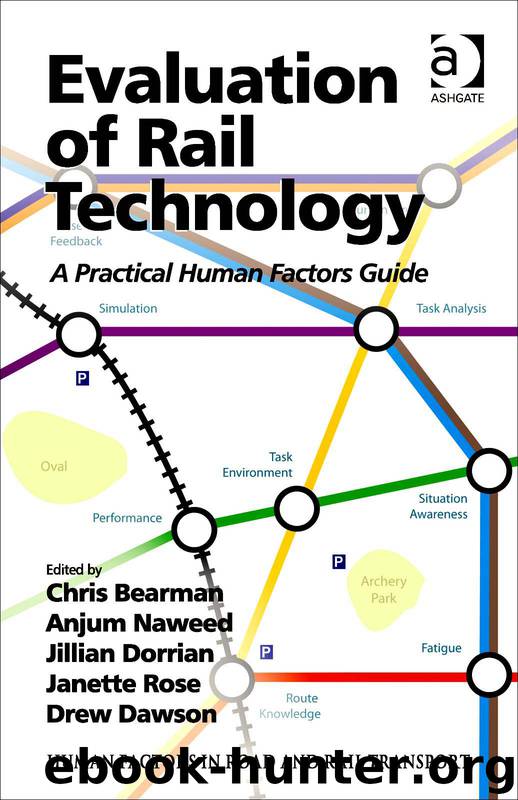Evaluation of Rail Technology by Chris Bearman & Anjum Naweed & Jillian Dorrian & Janette Rose & Drew Dawson

Author:Chris Bearman & Anjum Naweed & Jillian Dorrian & Janette Rose & Drew Dawson
Language: eng
Format: epub
Publisher: Ashgate
Published: 2013-03-14T16:00:00+00:00
Figure 7.7 One sub-goal of GDTA for achieving Flexible Manufacturing System planned output (adapted from Usher and Kaber, 2000, used by permission of John Wiley & Sons, Inc.)
Figure 7.8 Steps in critical decision method (adapted from Stanton et al., 2005)
There are numerous ways of analysing the information derived from a CDM study and the method chosen will depend upon the ultimate aim of the analysis. For example, a critical cue inventory may be used to gather information about specific cues used in assessing situations and considering choices of action, with the resulting data used to design training that is specific to that situation (Klein et al., 1989). Another form of analysis is to compile a situation assessment record in which critical cues and current goals are probed for each decision point (Klein et al., 1989). This provides a record of situation assessment strategies used by operators and how situation assessment may change due to observed cues that may result in a change to or replacement of previous goals (Klein et al., 1989).
The CDM has many possible applications such as evaluating systems aimed at aiding operators and identifying areas where training could improve performance (Klein et al., 1989). As an example of the latter, a task analysis using the critical decision method could be conducted to highlight differences between expert and novice operators. Training could then be designed to focus on those differences to speed up the process of learning for novice operators and improve their overall performance.
One of the advantages of the CDM is that it provides meaningful information about non-routine events that would not usually be captured in other task analysis methods (Klein et al., 1989). The iterative structure of the critical decision method ensures an in-depth analysis, and the probes and queries have been widely used and found to be fruitful in capturing decision-making processes (Klein and Armstrong, 2005). The CDM is relatively quick and easy to apply (Stanton et al., 2005) and coding of semi-structured interviews is also relatively straightforward (Klein et al., 1989).
A disadvantage of this process is that it relies on verbal reports, which may not be completely accurate (Klein et al., 1989). While the procedures used in the CDM (such as the use of neutral probes, in-depth recall of a situation) have been designed to minimise this potential bias (Klein et al., 1989), the reliance on verbal reports is still a limitation of the method. Another limitation of this method is that it requires a high level of resources for a relatively small dataset, however, the richness of the resulting data may justify the use of resources (Klein and Armstrong, 2005). Using the CDM requires a high level of expertise (Klein and Armstrong, 2005) and the data gathered is highly dependent upon the analyst’s skills and the quality of the participants (Stanton et al., 2005). For a detailed step-by-step procedure of how to conduct a CDM task analysis, see Stanton et al. (2005).
Example: O’Hare, Wiggins, Williams and Wong (1998) describe three studies in which they used the critical decision method.
Download
This site does not store any files on its server. We only index and link to content provided by other sites. Please contact the content providers to delete copyright contents if any and email us, we'll remove relevant links or contents immediately.
International Integration of the Brazilian Economy by Elias C. Grivoyannis(74582)
The Radium Girls by Kate Moore(11616)
Turbulence by E. J. Noyes(7697)
Nudge - Improving Decisions about Health, Wealth, and Happiness by Thaler Sunstein(7238)
The Black Swan by Nassim Nicholas Taleb(6761)
Rich Dad Poor Dad by Robert T. Kiyosaki(6174)
Pioneering Portfolio Management by David F. Swensen(6078)
Man-made Catastrophes and Risk Information Concealment by Dmitry Chernov & Didier Sornette(5644)
Zero to One by Peter Thiel(5487)
Secrecy World by Jake Bernstein(4387)
Millionaire: The Philanderer, Gambler, and Duelist Who Invented Modern Finance by Janet Gleeson(4089)
The Age of Surveillance Capitalism by Shoshana Zuboff(3981)
Skin in the Game by Nassim Nicholas Taleb(3965)
The Money Culture by Michael Lewis(3843)
Bullshit Jobs by David Graeber(3826)
Skin in the Game: Hidden Asymmetries in Daily Life by Nassim Nicholas Taleb(3720)
The Dhandho Investor by Mohnish Pabrai(3560)
The Wisdom of Finance by Mihir Desai(3523)
Blockchain Basics by Daniel Drescher(3327)
